Potentiometer(Rheostat)
A
potentiometer (
pron.: /pɵˌtɛnʃiˈɒmɨtər/), informally a
pot, is a three-
terminal resistor with a sliding contact that forms an adjustable
voltage divider.
[1] If only two terminals are used, one end and the wiper, it acts as a
variable resistor or
rheostat.
Potentiometers are commonly used to control electrical devices such as volume controls on audio equipment. Potentiometers operated by a mechanism can be used as position
transducers, for example, in a
joystick. Potentiometers are rarely used to directly control significant power (more than a
watt), since the power dissipated in the potentiometer would be comparable to the power in the controlled load.

PCB mount
trimmer potentiometers, or "trimpots", intended for infrequent adjustment.
[edit]Potentiometer construction
Potentiometers comprise a resistive element, a sliding contact (wiper) that moves along the element, making good electrical contact with one part of it, electrical terminals at each end of the element, a mechanism that moves the wiper from one end to the other, and a housing containing the element and wiper.
Many inexpensive potentiometers are constructed with a resistive element formed into an arc of a circle usually a little less than a full turn, and a wiper rotating around the arc and contacting it. The resistive element, with a terminal at each end, is flat or angled. The wiper is connected to a third terminal, usually between the other two. On panel potentiometers, the wiper is usually the center terminal of three. For single-turn potentiometers, this wiper typically travels just under one revolution around the contact. The only point of ingress for contamination is the narrow space between the shaft and the housing it rotates in.
Another type is the linear slider potentiometer, which has a wiper which slides along a linear element instead of rotating. Contamination can potentially enter anywhere along the slot the slider moves in, making effective sealing more difficult and compromising long-term reliability. An advantage of the slider potentiometer is that the slider position gives a visual indication of its setting. While the setting of a rotary potentiometer can be seen by the position of a marking on the knob, an array of sliders can give a visual impression of, for example, the effect of a multi-channel
equaliser.
The resistive element of inexpensive potentiometers is often made of
graphite. Other materials used include resistance wire, carbon particles in plastic, and a ceramic/metal mixture called cermet. Conductive track potentiometers use conductive polymer resistor pastes that contain hard-wearing resins and polymers, solvents, and lubricant, in addition to the carbon that provides the conductive properties. Others are enclosed within the equipment and are intended to be adjusted to calibrate equipment during manufacture or repair, and not otherwise touched. They are usually physically much smaller than user-accessible potentiometers, and may need to be operated by a screwdriver rather than having a knob. They are usually called "preset potentiometers". Some presets are accessible by a small screwdriver poked through a hole in the case to allow servicing without dismantling.
Multiturn potentiometers are also operated by rotating a shaft, but by several turns rather than less than a full turn. Some multiturn potentiometers have a linear resistive element with a slider which moves along it moved by a
worm gear; others have a
helical resistive element and a wiper that turns through 10, 20, or more complete revolutions, moving along the helix as it rotates. Multiturn potentiometers, both user-accessible and preset, allow finer adjustments; rotation through the same angle changes the setting by typically a tenth as much as for a simple rotary potentiometer.
A
string potentiometer is a multi-turn potentiometer operated by an attached reel of wire turning against a spring, enabling it to convert linear position to a variable resistance.
User-accessible rotary potentiometers can be fitted with a switch which operates usually at the anti-clockwise extreme of rotation. Before digital electronics became the norm such a component was used to allow radio and television receivers and other equipment to be switched on at minimum volume with an audible click, then the volume increased, by turning a knob. Multiple resistance elements can be ganged together and controlled by the same shaft, for example, in stereo audio amplifiers for volume control.
[edit]Resistance–position relationship: "taper"
The relationship between slider position and resistance, known as the "taper" or "law", is controlled by the manufacturer. In principle any relationship is possible, but for most purposes
linear or
logarithmic (aka "audio taper") potentiometers are sufficient.
A letter code may be used to identify which taper is used, but the letter code definitions are not standardized. Newer potentiometers will usually be marked with an 'A' for logarithmic taper or a 'B' for linear taper. Older potentiometers may be marked with an 'A' for linear taper, a 'C' for logarithmic taper or a 'F' for anti-logarithmic taper. When a percentage is referenced, with a non-linear taper, it relates to the resistance value at the mid-point of the shaft rotation. A 10% log taper would therefore measure 10% of the total resistance at the mid point of the rotation; i.e. 10% log taper on a 10K ohm potentiometer would yield 1K at the mid point. The higher the percentage the steeper the log curve
[2]
[edit]Linear taper potentiometer
A
linear taper potentiometer (
linear describes the electrical characteristic of the device, not the geometry of the resistive element) has a resistive element of constant cross-section, resulting in a device where the resistance between the contact (wiper) and one end terminal is
proportional to the distance between them. Linear taper potentiometers are used when the division ratio of the potentiometer must be proportional to the angle of shaft rotation (or slider position), for example, controls used for adjusting the centering of an analog cathode-ray
oscilloscope.
[edit]Logarithmic potentiometer
A logarithmic taper potentiometer has a resistive element that either 'tapers' in from one end to the other, or is made from a material whose resistivity varies from one end to the other. This results in a device where output voltage is a logarithmic function of the slider position.
Most (cheaper) "log" potentiometers are not accurately logarithmic, but use two regions of different resistance (but constant resistivity) to approximate a logarithmic law. The two resistive tracks overlap at approximately 50% of the potentiometer rotation, this gives a stepwise logarithmic taper.
[3] A logarithmic potentiometer can also be simulated (not very accurately) with a linear one and an external resistor. True logarithmic potentiometers are significantly more expensive.
Logarithmic taper potentiometers are often used in connection with audio amplifiers as human perception of audio volume is logarithmic.
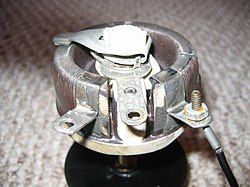
A high power wirewound potentiometer. Any potentiometer may be connected as a rheostat.
[edit]Rheostat
The most common way to vary the resistance in a circuit is to use a
rheostat,
[4] a two-terminal variable resistor. For low-power applications (less than about 1 watt) a three-terminal potentiometer is often used, with one terminal unconnected or connected to the wiper.
Where the rheostat must be rated for higher power (more than about 1 watt), they may be built with a resistance wire wound around a semicircular insulator, with the wiper sliding from one turn of the wire to the next. Sometimes a rheostat is made from resistance wire wound on a heat-resisting cylinder, with the slider made from a number of metal fingers that grip lightly onto a small portion of the turns of resistance wire. The "fingers" can be moved along the coil of resistance wire by a sliding knob thus changing the "tapping" point. Wire-wound rheostats made with ratings up to several thousand watts are used in applications such as DC motor drives, electric welding controls, or in the controls for generators.The rating of the rheostat is given with the full resistance value and the allowable power dissipation is proportional to the fraction of the total device resistance in circuit.
[edit]Digital potentiometer
A digital potentiometer is an electronic component that mimics the functions of analog potentiometers. Through digital input signals, the resistance between two terminals can be adjusted, just as in an analog potentiometer.
[edit]Membrane potentiometer
A membrane potentiometer uses a conductive membrane that is deformed by a sliding element to contact a resistor voltage divider. Linearity can range from 0.5% to 5% depending on the material, design and manufacturing process. The repeat accuracy is typically between 0.1mm and 1.0mm with a theoretically infinite resolution. The service life of these types of potentiometers is typically 1 million to 20 million cycles depending on the materials used during manufacturing and the actuation method; contact and contactless (magnetic) methods are available. Many different material variations are available such as
PET(foil), FR4, and Kapton. Membrane potentiometer manufacturers offer linear, rotary, and application-specific variations. The linear versions can range from 9mm to 1000mm in length and the rotary versions range from 0° to multiple full turns, with each having a height of 0.5mm. Membrane potentiometers can be used for position sensing.
[5]
[edit]Potentiometer applications
Potentiometers are rarely used to directly control significant amounts of power (more than a watt or so). Instead they are used to adjust the level of analog signals (for example
volume controls on
audio equipment), and as control inputs for electronic circuits. For example, a light
dimmer uses a potentiometer to control the switching of a
TRIACand so indirectly to control the brightness of lamps.
Preset potentiometers are widely used throughout electronics wherever adjustments must be made during manufacturing or servicing.
User-actuated potentiometers are widely used as user controls, and may control a very wide variety of equipment functions. The widespread use of potentiometers in consumer electronics declined in the 1990s, with
rotary encoders, up/down
push-buttons, and other digital controls now more common. However they remain in many applications, such as volume controls and as position sensors.
[edit]Audio control

Linear potentiometers ("faders")
Low-power potentiometers, both linear and rotary, are used to control audio equipment, changing loudness, frequency attenuation and other characteristics of audio signals.
The 'log pot' is used as the volume control in
audio power amplifiers, where it is also called an "audio taper pot", because the
amplituderesponse of the human
ear is approximately logarithmic. It ensures that on a volume control marked 0 to 10, for example, a setting of 5 sounds subjectively half as loud as a setting of 10. There is also an
anti-log potor
reverse audio taper which is simply the reverse of a logarithmic potentiometer. It is almost always used in a ganged configuration with a logarithmic potentiometer, for instance, in an audio balance control.
[edit]Television
Potentiometers were formerly used to control picture brightness, contrast, and color response. A potentiometer was often used to adjust "vertical hold", which affected the synchronization between the receiver's internal sweep circuit (sometimes a
multivibrator) and the received picture signal, along with other things such as audio-video carrier offset, tuning frequency (for push-button sets) and so on.
[edit]Motion Control
Potentiometers can be used as position feedback devices in order to create "closed loop" control, such as in a
servomechanism
[edit]Transducers
Potentiometers are also very widely used as a part of
displacement transducers because of the simplicity of construction and because they can give a large output signal.
[edit]Computation
In
analog computers, high precision potentiometers are used to scale intermediate results by desired constant factors, or to set
initial conditions for a calculation. A motor-driven potentiometer may be used as a
function generator, using a non-linear resistance card to supply approximations to trigonometric functions. For example, the shaft rotation might represent an angle, and the voltage division ratio can be made proportional to the cosine of the angle.
[edit]Theory of operation
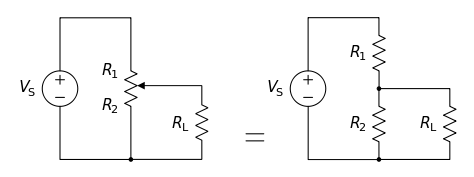
A potentiometer with a resistive load, showing equivalent fixed resistors for clarity.
The potentiometer can be used as a
voltage divider to obtain a manually adjustable output voltage at the slider (wiper) from a fixed input voltage applied across the two ends of the potentiometer. This is the most common use of them.
The voltage across

can be calculated by:

If

is large compared to the other resistances (like the input to an
operational amplifier), the output voltage can be approximated by the simpler equation:

(dividing throughout by  and cancelling terms with
and cancelling terms with  as denominator)
as denominator)
As an example, assume
 ,
,  ,
,  , and
, and 
Since the load resistance is large compared to the other resistances, the output voltage

will be approximately:

Due to the load resistance, however, it will actually be slightly lower: ≈ 6.623 V.
One of the advantages of the potential divider compared to a variable resistor in series with the source is that, while variable resistors have a maximum resistance where some
current will always flow, dividers are able to vary the output voltage from maximum (

) to
ground (zero volts) as the wiper moves from one end of the potentiometer to the other. There is, however, always a small amount of
contact resistance.
In addition, the load resistance is often not known and therefore simply placing a variable resistor in series with the load could have a negligible effect or an excessive effect, depending on the load.















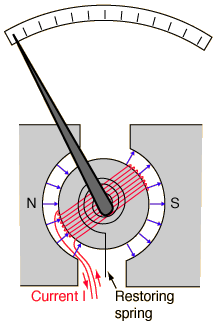
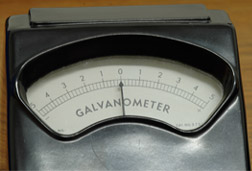
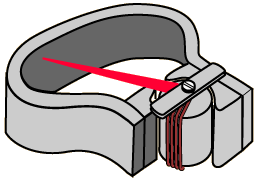


 where
where  . So the current can be found using the equation:
. So the current can be found using the equation:
 and R, we can solve for the unknown quantity
and R, we can solve for the unknown quantity  .
. resistor. Measure and record its actual value.
resistor. Measure and record its actual value. from Equation
from Equation 
 ) we can compute
) we can compute  .
.

 resistor.
resistor. and
and  , then the net emf is
, then the net emf is  ; in other words, the net emf is the difference between the
; in other words, the net emf is the difference between the  across the terminals of a cell is known as the terminal voltage (difference) and is measured in
across the terminals of a cell is known as the terminal voltage (difference) and is measured in  until exhausted, then dropping to zero. If such a cell maintained 1.5 volts and stored a charge of one
until exhausted, then dropping to zero. If such a cell maintained 1.5 volts and stored a charge of one 






 can be calculated by:
can be calculated by:

 ,
,  ,
,  , and
, and 
 will be approximately:
will be approximately:
 ) to
) to